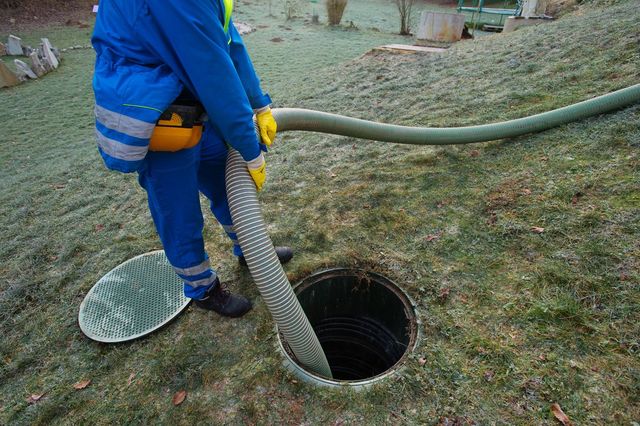Wastewater from your toilet (called blackwater) and your sinks, tubs, showers, washing machine, dishwasher, and clothes dryer (called greywater) runs into a septic tank. Once in the septic tank, solid materials sink to the bottom and form a layer called sludge. Fats, oils, and greases float to the top and form a layer called scum. The liquid between these layers is called effluent. Anaerobic bacteria in the septic tank treat this wastewater, converting organic materials into gases and liquids. Click Here to learn more.
When the sludge and scum layers get too thick, they must be pumped out. If this isn’t done regularly, the solid waste can clog the drain field, which will interfere with proper wastewater treatment and absorption.

The septic system’s drainage field is located in the soil around the home. It’s important not to cover it with a driveway, parking lot, or other impervious surface, as this can prevent wastewater from percolating into the ground.
It’s also important to only flush septic-safe items, like human and kitchen waste, paper products, and toilet tissue. Never flush non-septic-safe materials, like baby wipes, cotton swabs, cigarette butts, cat litter, hair, sanitary products, or cleaning chemicals. These can disrupt the natural breakdown process in the septic tank and clog pipes and pumps.
A septic tank works best when it receives a steady flow of water. Too much at once—multiple people taking showers, for example—can overwork the system and cause a back-up in your drains. This can be dangerous and costly to repair.
Regular septic tank maintenance is also important, including pumping it every 3 to 5 years and inspecting the baffle, tank lid, and vents for cracks or other damage. Keeping the yard free of debris and covering the drain field with a gravel-filled permeable area will also help protect the septic system and keep it functioning well.
Septic tanks that are not properly maintained or pumped out can overflow and cause a health hazard for homeowners, neighbors, and pets. Overflowing septic tanks can pollute surface and groundwater and lead to sewage backups and other wastewater issues.
Drain Field
A drain field (also known as an absorption field or leach field) removes and manages the sewage and waste material that leaves your home. This underground onsite sewage system takes the liquid waste from your septic tank, and slowly and evenly distributes it into the soil. It is important to keep your septic tank and drain field in good working condition, which requires routine maintenance by professionals and your own efforts.
Wastewater from your toilets, showers, tubs, sinks and washing machines flows into your septic tank through one main drainage pipe. Solid materials, such as food waste, feces and toilet paper, settle at the bottom of your septic tank in a thick, viscous layer called sludge. Lighter masses, such as soaps, oils and greases, float to the top of your septic tank in a film of scum. Anaerobic bacteria in your septic tank digest these materials. The resulting mixture of liquid and sludge exits your septic tank through inlet and outlet tees into the drain field.
Your septic tank’s drain field is a network of downward sloped pipes made of porous material, such as gravel, buried in the ground. The perforated pipes allow wastewater to seep into the ground, where the soil is able to filter out the remaining organic waste material.
To help protect your septic tank and drain field, landscape your property with grass and shrubs, instead of hard surfaces such as asphalt. Do not build structures over your septic tank or drain field, and ensure that downspouts are pointing away from your septic system. Trees or woody plants with deep roots may invade your septic tank drain field and cause problems.
If your septic tank and drain field are not properly maintained, it can lead to a complete failure of your septic system. This can result in sewage entering your home through toilets or drains, odors in the yard and runoff into rivers or lakes. To prevent this, have your septic tank inspected by a professional on a regular basis, and ensure that the system is pumped at least every three to five years.
Absorption Chambers
If you live on a property without a municipal sewer line, your wastewater goes into an on-site septic system instead of to a sewage treatment plant. That means you need to know how your septic system works and the best option for your home. One choice is the chamber septic system, which uses a series of buried chambers rather than gravel trenches to treat the wastewater.
In a conventional septic tank, the sludge layer settles on the bottom and the water floats on top. Bacteria in the septic tank do some basic sewage treatment, but the majority of the sewage treatment happens when the effluent enters the drain field and gets absorbed into the soil. Gravel acts as a filter, and it keeps the backfill soil from getting into the absorption area so the effluent can get absorbed more easily.
A septic tank is a concrete, fiberglass, or plastic underground structure through which domestic wastewater (sewage) flows for basic sewage treatment. The septic tanks contain a combination of solids and liquids for basic sewage treatment by settling and anaerobic digestion processes. The septic tanks also contain a lid, vents, and a pump to prevent septic tank odor.
After septic tank floats and sludge layers are separated, the liquid in the septic tank is discharged into the drainfield via an outlet pipe. The drainfield is designed to disperse the wastewater over a large area. This allows the septic system to absorb more of the wastewater than would be possible with a smaller leach field.
Some septic tank manufacturers offer products such as the Prinsco Pro4 36 chamber absorption field system that use a series of buried trenches that are designed to provide sewage treatment for up to four homes. A chamber system provides more space for a leach field than does a traditional pipe and gravel type septic system, which can save homeowners money in installation.
However, a chamber septic system is only recommended for sites where the soil is permeable enough to allow rapid seepage of wastewater. This is because the chambers store wastewater for longer than does a pipe and gravel system, and this may lead to a buildup of sludge in the leach field that causes the system to fail sooner than it would with a pipe and gravel system.
Vents
A septic tank needs to be vented to allow for air movement in and out of the system. The venting also helps to control unpleasant odors that occur when the waste decomposes anaerobiotically in the septic tank. The odors are a natural byproduct of this process, and the septic tank vent keeps them from reaching living areas of a home.
The septic tank vent is usually a 3 or 4 inch pipe that sticks out of the roof. The pipe is a part of the house plumbing, which means it’s also connected to the main vent stack for the whole house. It’s important to know where this pipe is so you can keep it clear of blockages or other issues that could affect the health and safety of your family.
The main reason for this ventilation is that the septic tank and leach field need oxygen to break down waste properly. If the bacteria in the septic tank don’t have enough oxygen, they won’t be able to get rid of waste quickly or completely. The vent keeps pressure stable in the septic system and lets gases like methane and hydrogen sulfide escape into the atmosphere.
In addition, the vent lets air enter the leach field to prevent a vacuum from building up and causing problems with the absorption system or the waste in the leach field. If a septic tank isn’t properly vented, it can be dangerous for the homeowner and neighbors as well.
Keeping your septic tank vent clear of blockages and other problems is essential for proper function. If you think there might be a problem with your septic tank vent, contact a professional right away. They can come out and take a look, clean the vent, and make sure that everything is working as it should.
Keeping your septic tank system healthy and functioning properly is good for your family, your neighbors, and your community. The best way to do this is to have regular maintenance from a certified septic technician. They’ll check your septic tank, drain fields, and other parts of the system for signs of problems and make any necessary repairs.







